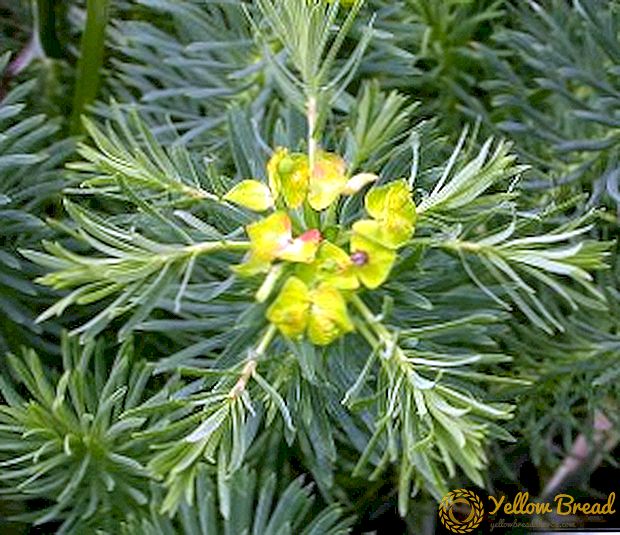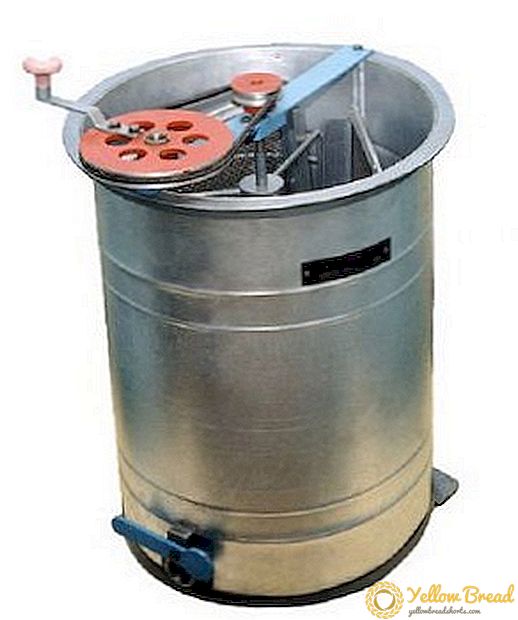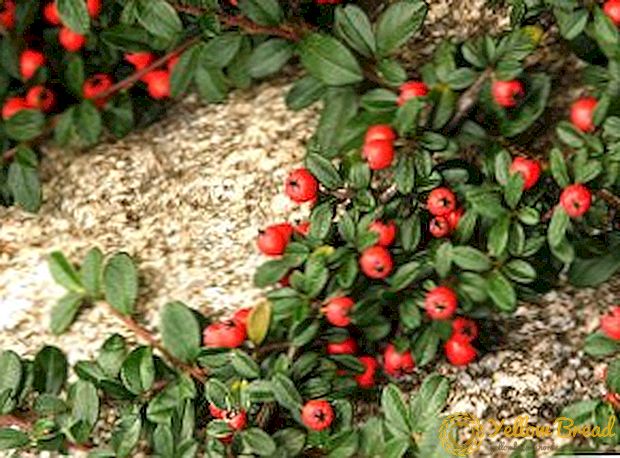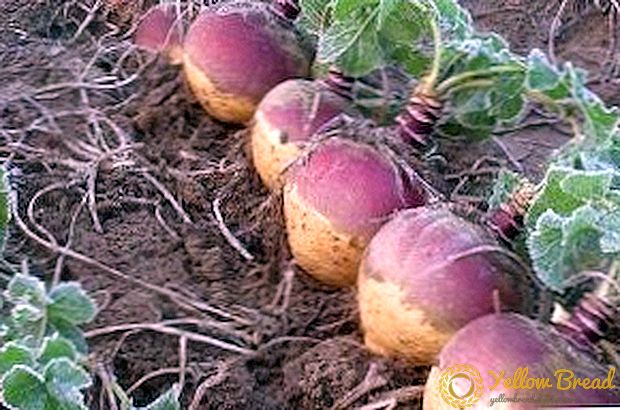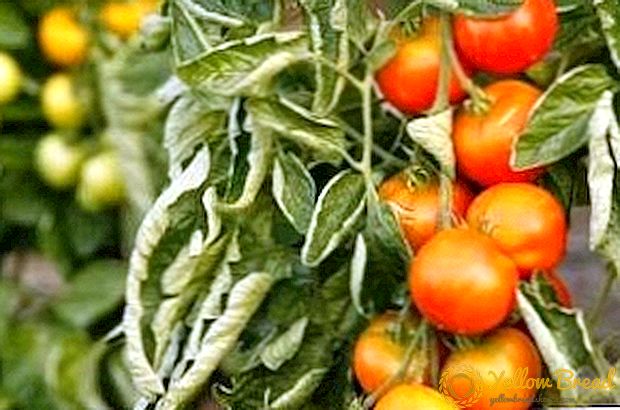 A gardener engaged in the cultivation of tomatoes should be aware of diseases that can affect this crop at different stages of its growth and development. This is a mandatory requirement for those who wish to get a healthy and generous harvest with good taste. Further in the article we will talk about fusarium - a very common disease of tomatoes. We learn what it is, what are the main signs of the presence of the disease, and also figure out how to deal with it.
A gardener engaged in the cultivation of tomatoes should be aware of diseases that can affect this crop at different stages of its growth and development. This is a mandatory requirement for those who wish to get a healthy and generous harvest with good taste. Further in the article we will talk about fusarium - a very common disease of tomatoes. We learn what it is, what are the main signs of the presence of the disease, and also figure out how to deal with it.
- What kind of disease and where does it come from
- Why is it dangerous
- Signs of defeat
- How to prevent illness
- Crop rotation
- Pre-seed preparation
- Soil disinfection
- Dip the roots of seedlings in the solution
- Other preventive measures
- Drugs against fusarium
- Biological
- Chemical
- Is it possible to fight in the active phase of development
- Resistant varieties
What kind of disease and where does it come from
Fusarium is a common and very dangerous fungal disease. This infectious disease can be caused by fungi of the genus Fusarium. It can manifest itself in almost all climatic regions.
Fusarium affects tissue and the vascular system of vegetables.The plant fades, the roots and fruits begin to rot. The problem is also the fact that the pathogen is able to stay in the soil for a long time, as well as on the remains of vegetation, after which it is possible to strike the newly planted crops with a new force.
The previously affected planting and seed materials may also provoke the occurrence of the disease. Still, as noted by experienced gardeners, the lack of lighting and thickening of the plantations can also cause the appearance of fusarium.  Equally important is the environmental factor. If a large-scale industrial production is located not far from the garden, then it can also have a negative impact on the yield of tomato culture.
Equally important is the environmental factor. If a large-scale industrial production is located not far from the garden, then it can also have a negative impact on the yield of tomato culture.
Among other things, closely located groundwater, excess or lack of nitrogen and chlorine-containing fertilizers, excessive or lack of irrigation, errors in crop rotation can cause fusarium wilt.
Why is it dangerous
Before you learn how to deal with tomato fusarium, you need to understand the danger it poses to this crop. Fusarium begins its negative impact by rooting the root system.
The fungus penetrates initially from the soil into the smallest roots, after which it moves into larger ones as the plants develop. Then the disease enters the stem through the vessels and spreads to the leaves.
The lower leaves quickly fade, while the rest acquire a watery appearance. Vessels of petioles and foliage become weak, sluggish, begin to sag along the stem. If the air temperature falls below 16 ° C, then tomato plants will die rather quickly.  If no measures are taken to treat the plant, then in 2-3 weeks the harvest will be completely destroyed. That is why it is very important to start fighting this disease as soon as possible.
If no measures are taken to treat the plant, then in 2-3 weeks the harvest will be completely destroyed. That is why it is very important to start fighting this disease as soon as possible.
Signs of defeat
Symptoms manifest in the direction of the bottom up.
- Initially, the disease can be noted on the lower leaves of the tomato culture. After some time, Fusarium affects the rest of the bush. Foliage turns pale or yellow, veins begin to brighten.
- The leaf stalks are deformed, and the leaves themselves curl into tubes, and then fall.
- Top shoots of tomato culture begin to fade. After some time, the plant dries out completely and dies.
- The last stage of the disease is the death of the root system.
- When wet weather on the roots may appear a raid of light shade, and in the heat of the symptoms even more aggravated.

How to prevent illness
We present the main methods of prevention that will help reduce the likelihood of tomato fusarium.
Crop rotation
To prevent the fusarium wilting of tomatoes is much easier than to treat it. First of all, it is important to observe the norms of crop rotation on the site. It is recommended to plant a tomato culture each year in a new garden.
Eggplants, peppers, physalis, and potatoes are good precursors. It is also highly desirable to add a large amount of organic fertilizer under the predecessors.
If this is done, there will be no need to cultivate the soil with nitrogen-containing fertilizers, which can provoke the formation of Fusarium.

Pre-seed preparation
To protect plants from fungal disease, it is recommended to seed dressing before sowing. To do this, use the tools of the benzimidazole group, which includes "Fundazol" and "Benazole".
They need to pickle the seed two weeks before sowing. For 1 kg of seed will need approximately 5-6 g of the drug.
The drug needs to be dissolved in water, after which the ready solution is poured into a hand-held sprayer. Seeds need to be placed in a container. Using a spray bottle, you need to spray the seeds and mix them, evenly distributing the product over their surface.
After 20-30 minutes Seed material should be scattered for complete drying, then put into bags and leave stored until the sowing period.
Soil disinfection
Before planting tomatoes on the plot, the beds also need to be disinfected from Fusarium. Before planting a tomato crop, the soil should be disinfected with copper sulfate, 70 g of which must be diluted in one bucket of water.
Also in the ground you can make dolomite flour or chalk,which will also help reduce the likelihood of fusarium manifestations, because the fungus-pathogens do not like a neutral type of soil, in which there is a lot of calcium.
In the autumn, after the crop is harvested, you can additionally pour the area with lime (100 g per 1 sq. M). Also in the autumn period, you can work the bed with a solution of potassium permanganate or a mixture of ash and powdered sulfur. 
Dip the roots of seedlings in the solution
Some gardeners practice not only the treatment of seeds and soil, but also seedlings before planting. The root system of tomato seedlings can be dipped in an antifungal solution for a few seconds, then dried slightly and transplanted into the ground.
Other preventive measures
Among other things, the gardener should know about other methods of preventing fungal disease:
- To provoke the development of Fusarium can excessively moist soil and high humidity.In this regard, it is necessary to air the greenhouse as often as possible if tomatoes grow in it, and not on an open garden bed.
- It is also important to loosen the soil and disinfect it before planting tomatoes. It is necessary to sterilize with the help of alcohol all working tools - knives, scissors, threads, wire (garter).
- Tomato culture requires enough light. Therefore, if there is a lack of natural lighting, it is necessary to use incandescent bulbs.
- It is important to provide tomato seedlings with temperature conditions ranging from 16 to 18 ° C.
- Seed material must not only pickle, but also to warm up before sowing.
- Tomato bushes are recommended from time to time to spud to a height of 13-15 cm.
- Oppress pathogenic fungi can black film, which should be mulching beds.
Drugs against fusarium
Drugs that help fight fusarium are divided into biological and chemical. Let us consider in more detail each of them.
Biological
Biological preparations that are used in the treatment of fusarium, do not contain any chemical components.This is a collection of bacteria that help fight the fungus.
The principle of their effectiveness is quite simple: the more good bacteria in the soil, the less there are harmful microorganisms. The ways to use them are as follows:
- "Trichodermin" is introduced into the substrate for tomato seedlings. Take 2 g of funds for each bush.
- The same "Trichodermin" can be applied to the soil at the rate of 1 kg per 10 square meters. m
- Tomatoes that have already been planted on a bed are watered with a solution of "Planriz" or "Pseudobactrin-2". Preparing a solution according to the instructions. On one bush will need approximately 100 ml of fluid.
Other biological agents that can be used in the fight against Fusarium are "Trihotsin", "Alirin-B" and "Hamair". For those who grow tomatoes on a large scale, avirulent isolates may be of interest.  This means for large-scale processing of the territory. They are able to colonize the site with beneficial bacteria, thereby increasing the resistance of the culture to pathogenic organisms.
This means for large-scale processing of the territory. They are able to colonize the site with beneficial bacteria, thereby increasing the resistance of the culture to pathogenic organisms.
Chemical
Chemicals are more effective than biological analogues. But they have a very important drawback: after treating a plot with such means for several weeks, the fruits that grow there cannot be consumed.
This must be remembered and processed at least 3 weeks before the intended harvest.
As practice shows, to combat fusarial wilting, it is necessary to add a large amount of lime or dolomite flour to the ground. It is also possible to treat the tomato bushes with a preparation containing copper and a solution of potassium permanganate.
Is it possible to fight in the active phase of development
Fusarium is a very dangerous disease of tomatoes, because both the spores and the fungi that trigger the disease are very resistant to chemical attack. The fact is that the main mass of fungi is not outside the plant, but inside, which is why it is extremely difficult to remove them, and sometimes it is impossible at all.  The seedlings, which were severely affected by the disease, cannot be treated anymore. It is necessary in such cases to remove the tops with the root and burn, because the harvest will not work anyway, and the infection from the diseased bush will spread to the healthy ones.
The seedlings, which were severely affected by the disease, cannot be treated anymore. It is necessary in such cases to remove the tops with the root and burn, because the harvest will not work anyway, and the infection from the diseased bush will spread to the healthy ones.
If the gardener doesn’t take any action to treat the tomato crop for a long time, the crop will be destroyed in just 2-3 weeks.
Resistant varieties
Varieties of tomatoes that do not wilt, practically does not exist. But there are those who have increased resistance to fusarium. These are hybrids "Story", "Carlson", "Rusich" and "Sun".
Also, as practice shows, tomato varieties that have a prolonged period of fruit formation are relatively persistent. Such can be called the varieties "De Barao", "Swallow", "Meron F1", "Orco F1", "Pink Giant" and others.
As you can see, fusarium wilt is an extremely unpleasant and dangerous disease. It is very important to diagnose its presence at the site in time in order to take action as soon as possible and to take up the treatment of plants.  The best option is high-quality prevention and compliance with the proper crop rotation.
The best option is high-quality prevention and compliance with the proper crop rotation.

